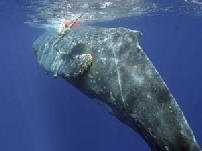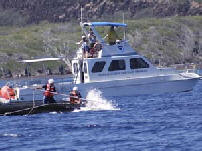EUROPEAN CETACEAN BYCATCH CAMPAIGN
"Man is but a strand in the complex web of life"
"Man is but a strand in the complex web of life"
Entangled humpback whale rescued in Hawaiian waters
NOAA News release
15th February 2006
Federal and state officials, along with local volunteers, teamed up to free a humpback whale from a life-
The whale was first spotted on 9th February off the Island of Hawaii by the Hawaiian Marine Mammal Consortium, a whale research organization and a member of the Whale Disentanglement Network. Since the entanglement was assessed as life threatening, the network decided to attach a tracking buoy to the animal to allow the gathering of personnel and equipment to safely cut the whale free.
Network coordinators David Mattila and Ed Lyman, staff with the NOAA Humpback Whale sanctuary, worked with HMMC and DLNR to coordinate a rescue attempt of the animal. Unfortunately, as teams got underway, VHF tracking indicated that the animal had moved north and offshore into the rough waters of the Alenuihaha Channel where network members were unable to work on the animal. The animal stayed in rough waters throughout Saturday and then moved to calmer waters near Maui on Sunday where it was spotted by a whale watch boat. The team from the sanctuary reassembled and responded, working under Permit No 932-
This is the first successful disentanglement in Hawaii this whale season and the first disentanglement that involved using a small VHF radio tracking buoy. The buoy, which was attached to the animal, allowed rescuers to track the whale until it was safe enough to attempt a rescue effort.
This event is the third confirmed report of an entangled humpback whale this season. The first report of an entangled humpback was received Dec. 27, 2005. The report was of a whale five miles off Lihue, Kaua'i. The animal was reported trailing very little gear, had no visible wounds and looked healthy. The entanglement was assessed as not life threatening, and no immediate action was taken. The second report of a humpback with gear tightly wrapped and embedded around the base of its tail was received on the 29th January. The animal also was sighted off the island of Hawaii by the HMMC. This entanglement was assessed as life threatening, and an exhaustive effort was made to relocate the animal the next day to attempt to cut the animal free. Unfortunately, the animal has not been re-
Over the past couple of years, the number of confirmed reports of entangled whales in Hawaiian waters has increased. Large whales like the humpback, are typically able to rip the gear off the ocean floor and swim off with it. In fact, many of the whales reported entangled in Hawaiian waters probably brought the entanglement with them from higher latitude feeding grounds. While these large animals are not typically at risk from drowning or immediate death, they are at increased risk of starvation, infection, physical trauma from the gear and ship strikes as a result of the entanglement.
For those reporting possible entanglements, it should be noted that sometimes the behaviour of the animals or the animal's appearance may be mistaken for an entanglement. Do not use the whale's behaviour alone as an indication of entanglement.
Some examples of false reports are:
Mother and calf humpbacks logging (a typical behaviour of laying motionless at the surface) in shallow water and close to shore. They are just resting.
Surface active whales (breaching or part of a group of male humpbacks chasing after a female). With such behaviours there is typically a great deal of white water associated with throwing all or part of the body out of the water.
Humpbacks with white pectoral fins. The pectoral fins are 15 feet long or about 1/3 the length of the body. Only 25 percent of Hawaii's humpbacks have white fins and those that have them may be mistaken for gear laying next to the animal. In many cases the white fins may appear light green underwater and can be mistaken for gillnet.
If you believe you have seen an entangled whale or sea turtle, please call the NOAA Fisheries Hotline at (888) 256-
The process of cutting a large, free-
The Hawaiian Island Disentanglement Network has experienced and trained personnel that are authorized to safely cut large whales free of gear and marine debris using specially designed tools and techniques. The network in Hawaii is a partnership of federal, state and local members that also includes staff from NOAA Fisheries Pacific Islands Regional Office and the Marine Mammal Health and Stranding Response Program.
The disentanglement network operates in other parts of the United States and its regional teams have successfully freed more than 50 large whales over the years along the East Coast of the United States and Canada, the Caribbean, Alaska and in Hawaii without a single serious injury. Last year the Network's Disentanglement team successfully freed a humpback whale off western Maui that was entangled in marine debris.
While cutting an animal free of a life threatening entanglement may save the animal, it is not the long-
NOAA, an agency of the U.S. Department of Commerce, is dedicated to enhancing economic security and national safety through the prediction and research of weather and climate-
Through the emerging Global Earth Observation System of Systems (GEOSS), NOAA is working with its federal partners and nearly 60 countries to develop a global monitoring network that is as integrated as the planet it observes.
Relevant Web Sites
NOAA Hawaiian Islands Humpback Whale National Marine Sanctuary
NOAA National Marine Sanctuary Program
NOAA Fisheries Service
NOAA Ocean Service
Media Contact:
Ben Sherman, NOAA Ocean Service, (301) 713-
Top

Click here for
larger view of efforts to
disentangle a humpback whale in Hawaiian
waters taken 12th February, 2006.
NOAA image shows the humpback whale is
seen entangled in gear prior to removal.
Click here for NOAA’s high
larger view of efforts to
disentangle a humpback whale in Hawaiian
waters taken 12th February, 2006.
NOAA image shows the humpback whale is
seen entangled in gear prior to removal.
Click here for NOAA’s high

Click here for a larger view of the NOAA photograph of
efforts to disentangle a
humpback whale in Hawaiian waters.
Here rescuers use a pole to remove gear.
Click here for NOAA’s high resolution version taken 12th February 2006

Click here for a larger image of NOAA’s efforts to disentangle a humpback whale in Hawaiian waters taken 12th February 2006.
Here rescuers position themselves to remove entangled gear.
Click here for high resolution version taken on 12th February 2006
Here rescuers position themselves to remove entangled gear.
Click here for high resolution version taken on 12th February 2006
ALL IMAGES USED
WITHIN THIS PAGE
ARE
COURTESY
OF
NOAA
WITHIN THIS PAGE
ARE
COURTESY
OF
NOAA